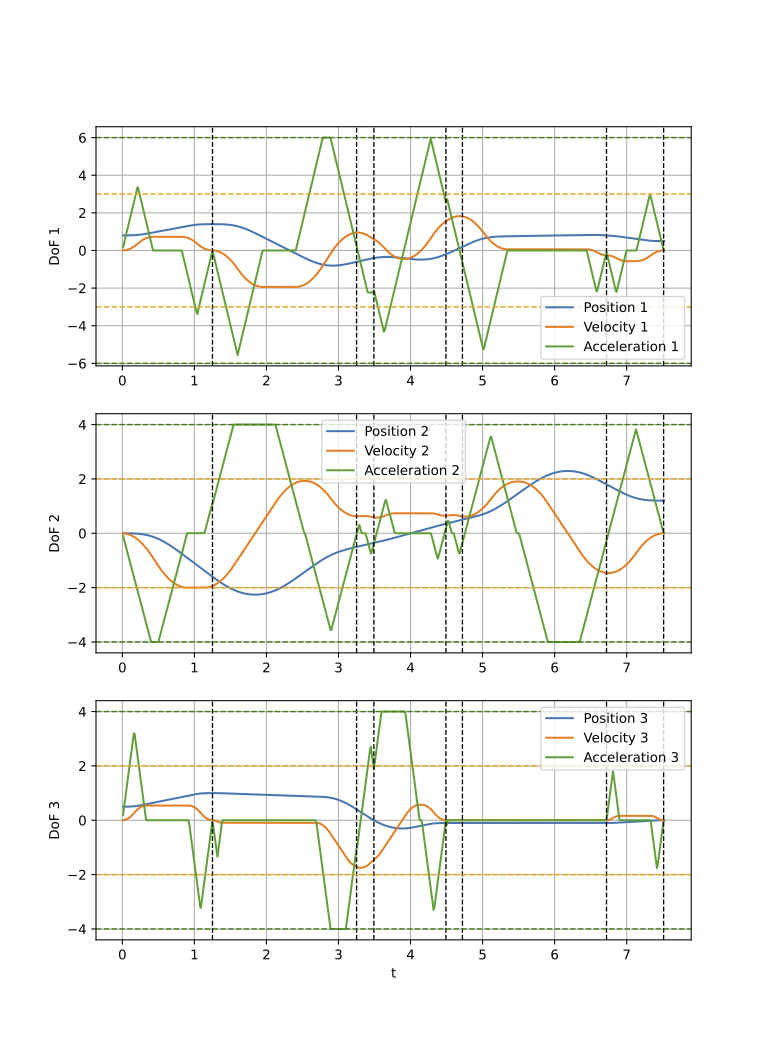Example 08: Per-section Minimum Trajectory Duration
C++
// This example shows the usage of intermediate waypoints. It will only work with Ruckig Pro or enabled cloud API.
#include <ruckig/ruckig.hpp>
#include "plotter.hpp"
using namespace ruckig;
int main() {
const double control_cycle = 0.01;
const size_t DOFs = 3;
const size_t max_number_of_waypoints = 10; // for memory allocation
// Create instances: the Ruckig trajectory generator as well as input and output parameters
Ruckig<DOFs> ruckig(control_cycle, max_number_of_waypoints);
InputParameter<DOFs> input;
OutputParameter<DOFs> output(max_number_of_waypoints);
// Set input parameters
input.current_position = {0.8, 0.0, 0.5};
input.current_velocity = {0.0, 0.0, 0.0};
input.current_acceleration = {0.0, 0.0, 0.0};
input.intermediate_positions = {
{1.4, -1.6, 1.0},
{-0.6, -0.5, 0.4},
{-0.4, -0.35, 0.0},
{-0.2, 0.35, -0.1},
{0.2, 0.5, -0.1},
{0.8, 1.8, -0.1}
};
input.target_position = {0.5, 1.2, 0.0};
input.target_velocity = {0.0, 0.0, 0.0};
input.target_acceleration = {0.0, 0.0, 0.0};
input.max_velocity = {3.0, 2.0, 2.0};
input.max_acceleration = {6.0, 4.0, 4.0};
input.max_jerk = {16.0, 10.0, 20.0};
// Define a minimum duration per section of the trajectory (number waypoints + 1)
input.per_section_minimum_duration = {0, 2.0, 0.0, 1.0, 0.0, 2.0, 0};
std::cout << "t | position" << std::endl;
double calculation_duration = 0.0;
while (ruckig.update(input, output) == Result::Working) {
std::cout << output.time << " | " << pretty_print(output.new_position) << std::endl;
output.pass_to_input(input);
if (output.new_calculation) {
calculation_duration = output.calculation_duration;
}
}
std::cout << "Reached target position in " << output.trajectory.get_duration() << " [s]." << std::endl;
std::cout << "Calculation in " << calculation_duration << " [µs]." << std::endl;
}
CustomVector< double, DOFs > target_position
Target (goal) state.
Definition input_parameter.hpp:193
CustomVector< double, DOFs > current_acceleration
Definition input_parameter.hpp:190
CustomVector< double, DOFs > current_velocity
Definition input_parameter.hpp:190
CustomVector< double, DOFs > max_velocity
Velocity limit.
Definition input_parameter.hpp:196
CustomVector< double, DOFs > current_position
Current (start) state.
Definition input_parameter.hpp:190
CustomVector< double, DOFs > max_jerk
Jerk limit.
Definition input_parameter.hpp:202
CustomVector< double, DOFs > target_velocity
Definition input_parameter.hpp:193
std::optional< std::vector< double > > per_section_minimum_duration
Definition input_parameter.hpp:244
CustomVector< double, DOFs > target_acceleration
Definition input_parameter.hpp:193
CustomVector< double, DOFs > max_acceleration
Acceleration limit.
Definition input_parameter.hpp:199
std::vector< CustomVector< double, DOFs > > intermediate_positions
Intermediate waypoints (only in Ruckig Pro)
Definition input_parameter.hpp:211
Definition block.hpp:16
std::string pretty_print(const Vector &array)
Join a vector for pretty printing (e.g. to std::cout)
Definition plotter.hpp:11
Python
# This example shows the usage of intermediate waypoints.
# It will only work with Ruckig Pro or enabled cloud API (e.g. default when installed by pip / PyPI).
from copy import copy
from ruckig import InputParameter, OutputParameter, Result, Ruckig
if __name__ == '__main__':
# Create instances: the Ruckig OTG as well as input and output parameters
otg = Ruckig(3, 0.01, 10) # DoFs, control cycle rate, maximum number of intermediate waypoints for memory allocation
inp = InputParameter(3) # DoFs
out = OutputParameter(3, 10) # DoFs, maximum number of intermediate waypoints for memory allocation
inp.current_position = [0.8, 0, 0.5]
inp.current_velocity = [0, 0, 0]
inp.current_acceleration = [0, 0, 0]
inp.intermediate_positions = [
[1.4, -1.6, 1.0],
[-0.6, -0.5, 0.4],
[-0.4, -0.35, 0.0],
[-0.2, 0.35, -0.1],
[0.2, 0.5, -0.1],
[0.8, 1.8, -0.1],
]
inp.target_position = [0.5, 1.2, 0]
inp.target_velocity = [0, 0, 0]
inp.target_acceleration = [0, 0, 0]
inp.max_velocity = [3, 2, 2]
inp.max_acceleration = [6, 4, 4]
inp.max_jerk = [16, 10, 20]
# Define a minimum duration per section of the trajectory (number waypoints + 1)
inp.per_section_minimum_duration = [0, 2.0, 0.0, 1.0, 0.0, 2.0, 0]
print('\t'.join(['t'] + [str(i) for i in range(otg.degrees_of_freedom)]))
# Generate the trajectory within the control loop
first_output, out_list = None, []
res = Result.Working
while res == Result.Working:
res = otg.update(inp, out)
print('\t'.join([f'{out.time:0.3f}'] + [f'{p:0.3f}' for p in out.new_position]))
out_list.append(copy(out))
out.pass_to_input(inp)
if not first_output:
first_output = copy(out)
print(f'Calculation duration: {first_output.calculation_duration:0.1f} [µs]')
print(f'Trajectory duration: {first_output.trajectory.duration:0.4f} [s]')
# Plot the trajectory
# from pathlib import Path
# from plotter import Plotter
# project_path = Path(__file__).parent.parent.absolute()
# Plotter.plot_trajectory(project_path / 'examples' / '08_trajectory.pdf', otg, inp, out_list, plot_jerk=False)
Output Trajectory
